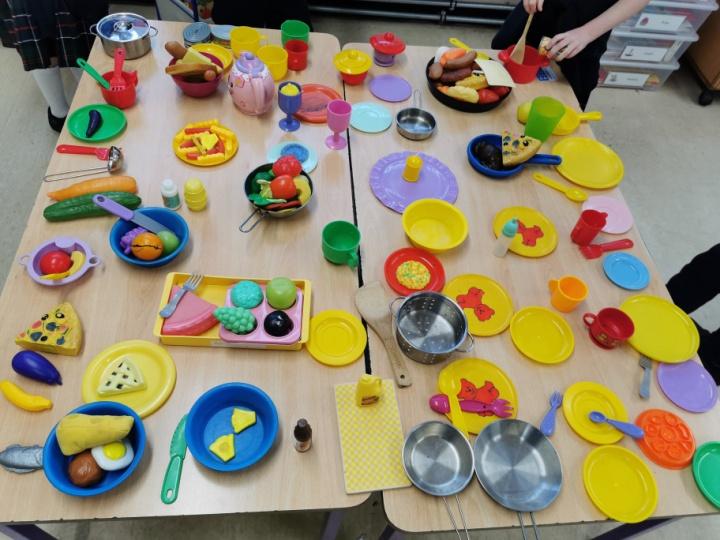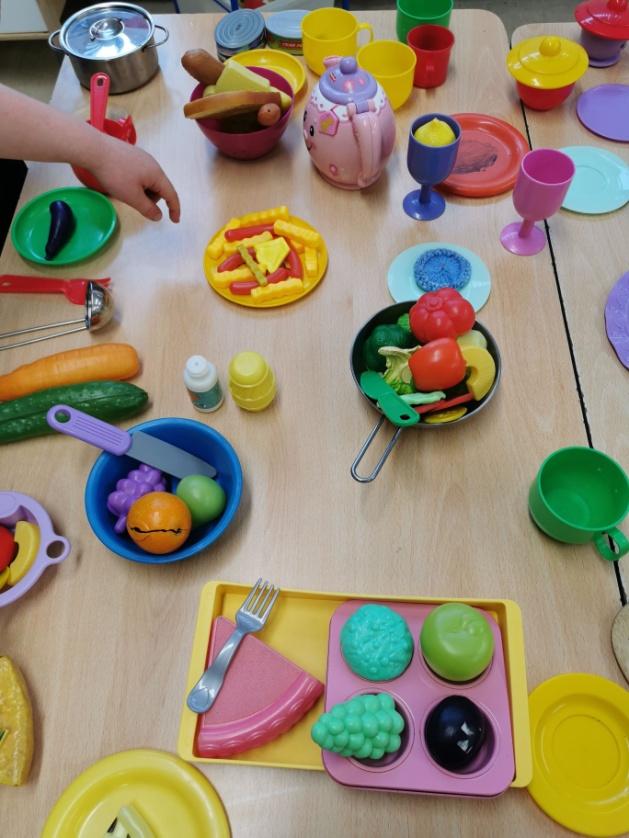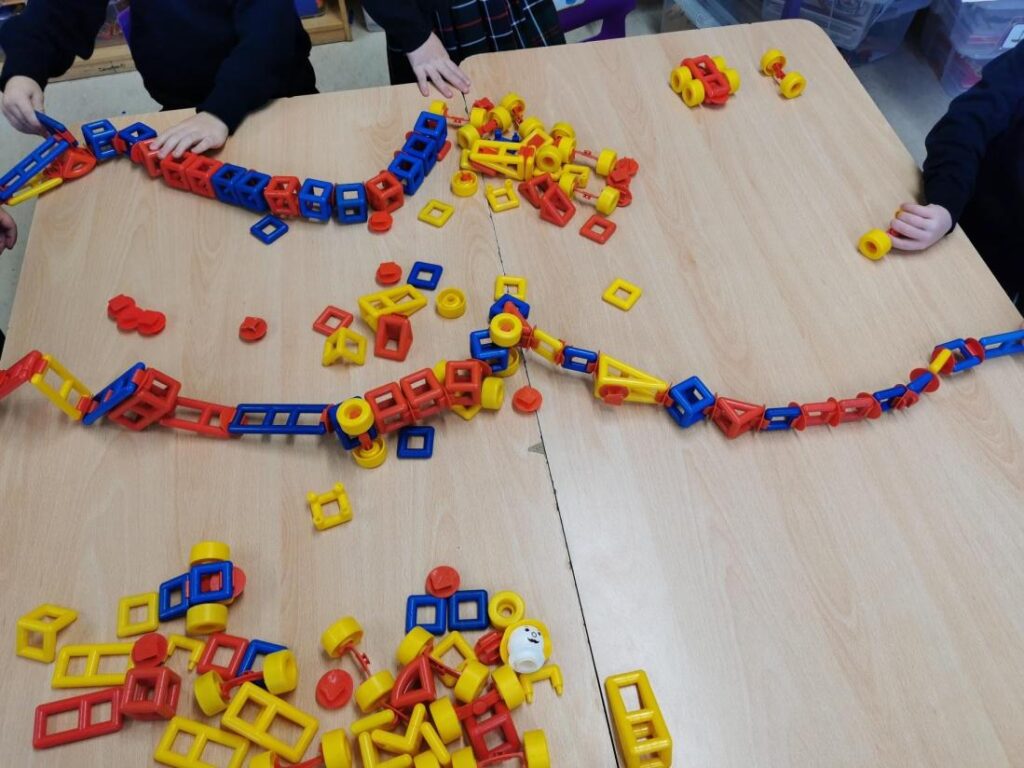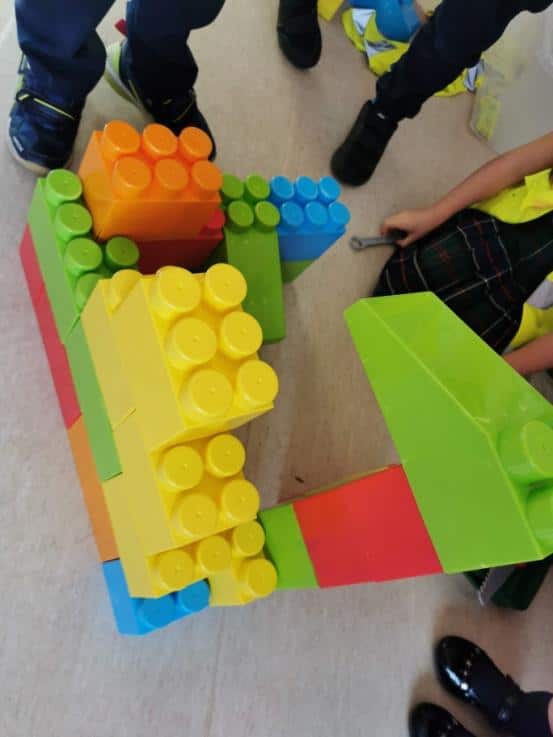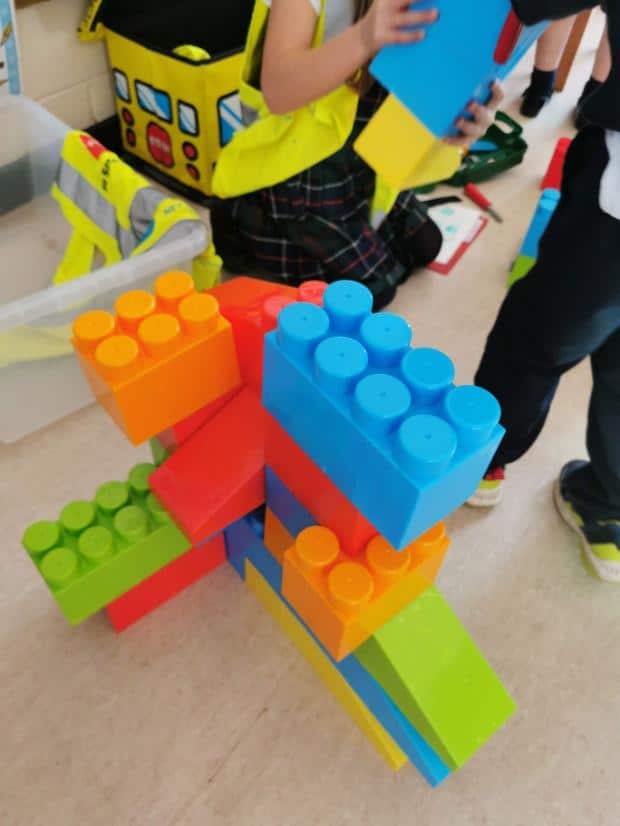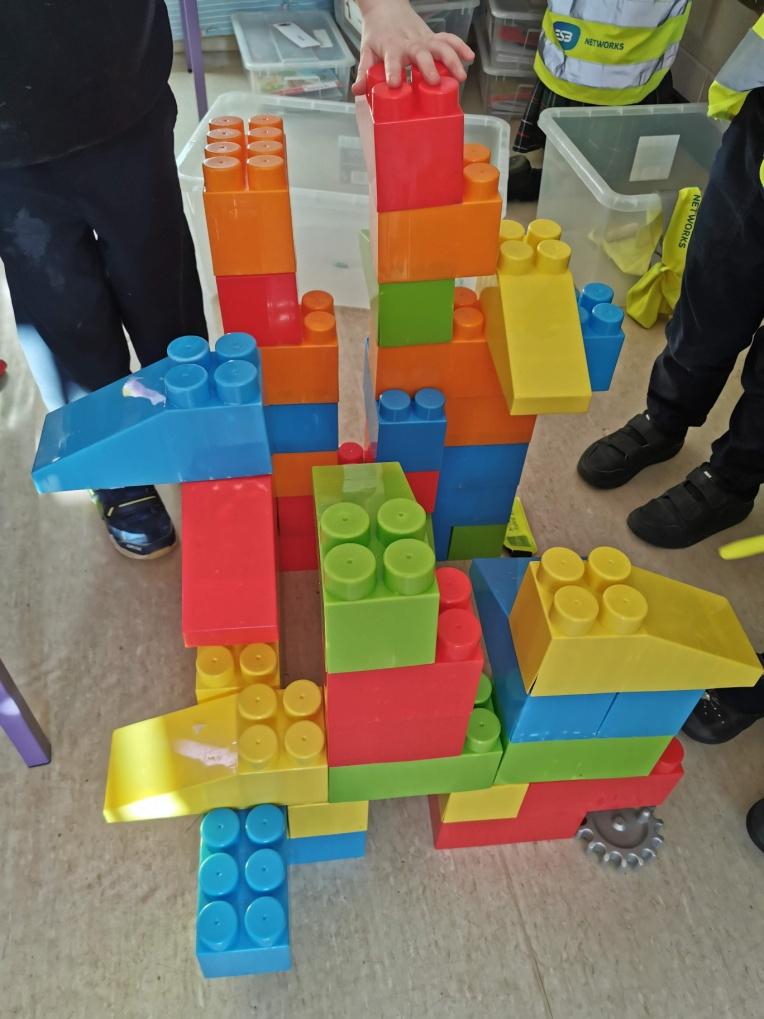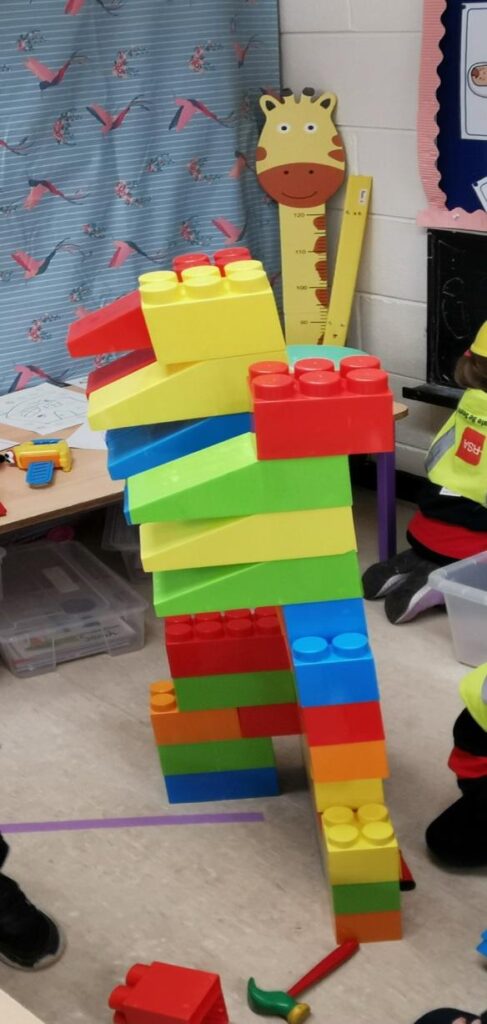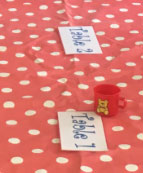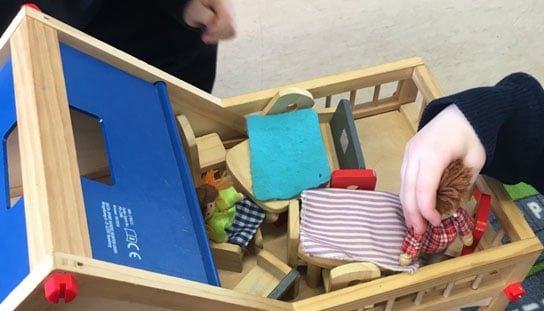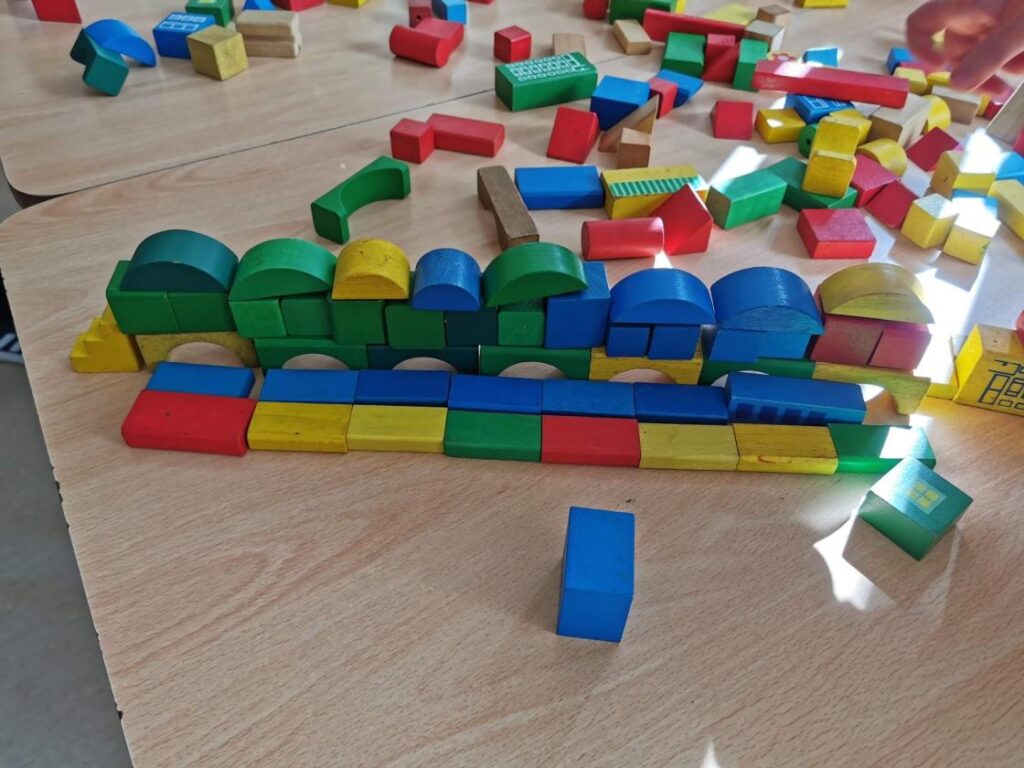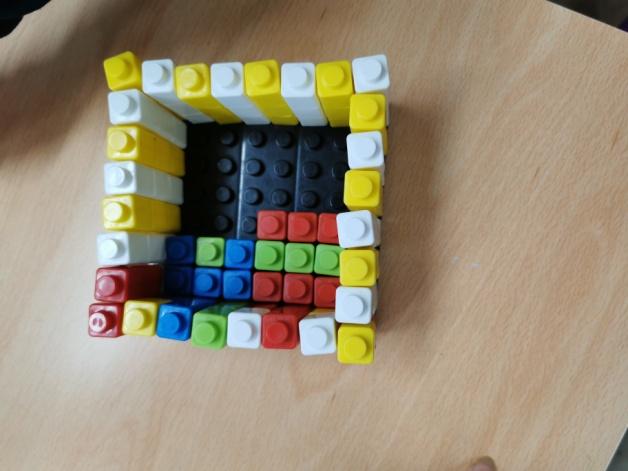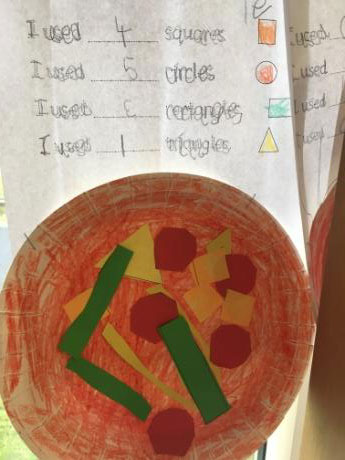The examples on this page show how one junior infant teacher used the ‘Notice, Explore, Talk about maths’ approach to supporting children’s mathematical development in play.
In the socio dramatic corner, the children are playing with the toy kitchen. Beside the toy kitchen there is one box of food and another box filled with plates/cutes/pots/cutlery.
Teacher’s Role: I entered the children’s play by noticing their table covered with all the contents of the two boxes emptied out.
Teacher ‘This table looks very interesting? What is going on today?’
Child 1: ‘We are at a hotel.’
Child 2: ‘This is all the food you get at a hotel.’
Child 3:’ You need lots of things for a hotel for all the people.’
In the opening lines the children were explaining their reasons for using everything. The children continued to tell me all about the different things you could get at the hotel. As I observed, I noticed that they used their mathematical thinking to describe what was going on.
Notice
Sorting was the key element of their play: They had sorted a salad bowl, a fruit salad bowl, some chips and sausage plate, a breakfast plate and a place to get the plates.
Explore
The children made sense of their play using mathematics. When the children explained the different things on the table they were guided to communicate and reason the decisions they made in setting up their play.
Teacher: ‘I’m very hungry looking at all this food, what can I order?’
Child 1: ‘You can have a salad’
Teacher: ‘That sounds lovely, what is in the salad?’
Child 1: ‘It is all vegetables, (points to the bowl) that makes a salad’
Child 2: ‘Here are the chips and the sausages’
Child 1: ‘And these are all fruit’
Teacher: ‘I really like how you have laid everything out on your table’
Child 2: ‘We sorted things!’
Teacher: ‘Oh you were sorting! Why did you sort?’
Child 3: ‘…because they go together, look there is breakfast foods!’
Talking about Mathematics
The children’s understanding of sorting was at the heart of this play. They made connections to real life sorting by playing with the different types of food categories e.g. fruit, vegetables, breakfast, dinner. They were confident in their reasoning on why they sorted the food items. The children were playing with ‘real life’ and using their play to make sense of what goes on, e.g., when they go to a hotel.
Noticing, exploring and talking about the mathematics the children played with encouraged the children to explain their thinking even further.
Teacher: ‘I really like how you used your math sorting skills today.’
The children were delighted when they made the mathematical learning connection in their play. ‘I love sorting’, ‘I am very good at sorting’ were some of the phrases observed in the aftermath of this play moment.
The children were involved in making their learning in play visible and enjoyed celebrating this moment with their peers in the review stage of play.
Notice
Size- the children wanted to make their snake train as long as they possibly could.
Explore
The teacher’s role was to help them to explore the topic of length further. Through a guided discussion the children decided they needed to compare the lengths of the different trains.
‘How can we figure out which snake train is the longest?’
‘How can we be sure our answer is correct?’
Talk about Mathematics
The aim of the questioning was to guide the children towards comparison and encourage the children to justify their answers. We had spent some time comparing the length of items as part of our maths lessons a few weeks previously.
The children needed time to find a fair way to measure their snake trains. Encouraging the children to come up with a few possible strategies allowed the children to build their problem-solving skills. The children used a trial and error strategy to find a way to prove which snake train was the longest. They decided they could use the width of the table. They decided starting at the edge of the table was a good idea to compare the length of each snake train.
Question samples: ‘I wonder what we can do? /How can we try to measure? /Are there any problems with our measuring ideas? ‘
I have noticed by making the children’s learning visible to them it has helped to build children’s productive disposition and curiosity for mathematics.
‘I noticed you were using some problem-solving skills today.’
‘I like your thinking, can you explain that to me again?’
‘I can see you are using your maths skills about measuring length that we have been learning.’
Notice
‘We have the tallest building’, ‘We want to make it taller’.
Children were discussing the height of their building and comparing the two different buildings.
Explore
‘Can you tell me what you are doing today?’ ,
‘I wonder how you could make your building taller?’
Through exploration the children decided they could put the two structures together. In the first attempt, the children tried to put one on top of the other. Some of the children in the group alerted the others that the idea would not work.
‘What is our problem?’
‘Have you got any ideas how we might solve it?’
In this scenario, the children’s play was embedded in the mathematical concept of size and trying to increase the size of their building. The children embedded their play in a problem-solving style scenario. They identified that putting one structure on top of the other was a problem.
Child 1: ‘It is going to fall’
Teacher: ‘Why is it going to fall?’
Child 2: ‘Everyone we need to stop!’
Child 1: ‘It is too big’
The children’s conversation was guided to explore why this method wasn’t going to work. The children explored ideas of height and weight and they used their reasoning skills to justify why. This scenario was identified as a problem and the children brainstormed ideas how they could make it work. They used trial and error in their building to help them build a taller tower.
Talk about Mathematics
The children discussed which building was the tallest and what it means to be the tallest. Children identified as problem-solvers during this task. The children’s growth mindset to solve this problem was apparent as they eagerly got stuck into trying out different approaches.
Through a trial and error strategy the children realised on their first attempt they made their building bigger but not taller. Teacher: ‘How will you know if your building is taller?
The children discussed ways to measure or compare their old towers to new ones.
Teacher: ‘ I can see you are thinking of different ways to solve this problem.’
They used their reasoning skills to settle on their final decision.
Child 4: ‘It is almost the height of our giraffe’
Child 2: ‘And giraffes are tall. ’
The play was celebrated when completed. The children explained their play to their peers. The children were guided by the teacher in showing others the mathematics that was involved in the play.
I placed a great amount of emphasis on the idea of the children as problem solvers. We discussed how the children used a trial and error strategy to make a tower that was taller. I have noticed by making this visible to the children they are more eager to try solve the ‘big problems’ that arise in our classroom.
Examples of Mathematics in Children’s Play
As explained above, the three types of mathematical play outlined by Ginsburg (2006) are:
- Mathematics embedded in play
- Children make sense of things by using mathematics in their play.
- Play centring on mathematics
- Children play with mathematics directly. They are focused and enjoying counting, creating a pattern, or making the longest train or snake.
- Play with the mathematics that has been taught
- Children recreate ideas and concepts explored in previous mathematical lessons.
Below you will find some examples of how these different types of play and how the teacher worked to notice, explore and talk about children’s ideas.
Math Ideas
Notice
Size- ‘It is a very big house.’
Time & Problem Solving: ‘I don’t have time to build the whole house.’
‘… because it is going to take a very long time to build two stories.’
Ordinal Number: ‘This is the first floor. ‘
Explore
‘What do you mean you don’t have enough time?’
From here the child explained their thinking; they wanted to build a two storey house just like their real house. Using a guided conversation the child was able to reason, argue and justify they couldn’t build two stories right now because they had no stairs and it already took them a long time to build the first floor.
Talk about mathematics
We discussed building houses and the time it takes to build.
Teacher ‘I really like how you used your thinking skills today.’
‘I noticed some maths talk today, did you?’
Math Ideas
Notice
Number- They asked questions e.g. ‘how many people?’
Matching sets using one to one correspondence: They give each customer the pieces of cutlery
Time: They told their customers they have to wait for 5 minutes for a table to be free
Ordinal number: They brought the dinner first, the dessert second.
Money: ‘It will be 5 euro.’.
Explore
‘We have a problem’
During play the children introduced a problem into their play. ‘We have too many customers.’ Later we explored this problem and the children discussed how they solved this problem. ‘How did you solve your problem in the restaurant today?’
Talk about mathematics
Highlighting the children’s use of mathematics skills builds their confidence and learning disposition in mathematics. ‘ I wonder did we use any maths skills today’, ‘I really liked how you used your problem solving skills today.’, ‘I like the way you came up with lots of ideas to try solve this problem.’
Math Ideas
Notice
Size: ‘We don’t have enough room’, ‘The chairs are squashed’, ‘The table cloth looks too big’.
Explore
‘You said you do not have enough room, what could you do to solve this problem?’
Talk about mathematics
‘I see you are using your mathematical thinking today. Do you know what I noticed?’
Math Ideas
Notice
Sorting: This looks interesting; can you tell me about what you built today?
‘I built a wall.’
(How did you build your wall?)
‘I used different types of blocks.’
Pattern: ‘(child’s name) used a pattern.
Explore
‘(child’s name) used a pattern, what do you mean? ‘
‘Well they used all the same blocks here.’
This discussion led to further exploration of this child’s understanding of pattern. We discussed what it means to make a pattern. The child was guided towards identifying the red, yellow, yellow, green, red, yellow, yellow, green row of blocks as a pattern.
Talk about mathematics
‘How did you build this?’
The child explained by getting blocks that are the same they were able to make this. We explored that they used their sorting skills to help them build this structure.
Math Ideas
Notice
Problem-solving: The children noticed a mistake in their pattern. Some were disappointed and others said it was on purpose. (reasoning skills)
Number: The number of floors
Size: ‘It’s a big skyscraper’
Pattern and colour: ‘blue, green, yellow, red, white, blue, it is meant to be green then yellow, red and white’, ‘There is a pattern with the black’.
Explore
‘I wonder how we can fix this problem in the pattern?’ The children explore different solutions to correcting their pattern mistake.
Talk about mathematics
‘I really like all the solutions you came up with to solve this problem’. , ‘I noticed you were using your maths skills.’
Math Ideas
Notice
Number-‘We have built it in twos, except for the middle part, we wanted a design’.
Pattern: ‘It is a pattern’. ‘That is where the people sit’.
2D shape: ‘We have a circle for a window so they can look out over the city’.
Explore
‘Tell me about your tower?’, ‘How did you build it?’
Talk about mathematics
In this scenario, the child were able to reason why they chose different designs for the different parts of their tower. ‘I really like your design and your reasons for choosing the different designs.’, ‘I noticed you were doing lots of thinking here to build your tower.’
Math Ideas
Notice
Pattern: ‘I wanted to build a pattern house.’, ‘ I wanted to use patterns like we do (in our maths stations).’
Number: ‘Look I nearly have 3 rows of the floor done.’, ‘ I’ve three more to do.’, ‘ I know 3 and 3 makes 6.’
Ordinal Number: ‘Here is the first, second, third row’
Explore
‘What did you build today?’
Echoing the children’s words back to invite further discussion ‘You wanted to build a pattern house?’ ‘What are you doing here? (point towards the black base)’
Talk about mathematics
‘I can see lots of mathematics in your construction, what can you see?’
In this scenario, the child was very confident with their mathematical knowledge. However, the first response when asked why did you build a pattern house was closed; ‘because I wanted to’. The child needed further guidance to help communicate their thinking. Once we got there, the child took over the conversation and the mathematics that they have been learning about came naturally to this conversation.
Math Ideas
Notice
Size- ‘It is a small cafe’.
Number: ‘It only has 4 chairs’.
Matching equivalent sets using one-one correspondence: ‘1 customer per table’
Time: ‘They don’t be there long. It is like fast food’.
Explore
‘This looks interesting, what are the little characters doing? , ‘Is a small cafe a problem?
Talk about mathematics
‘I noticed you talked about time here, why is that important in your play?’
Math Ideas
Notice
Ordinal Number: They told the sequence of their recipe to make pizza. What came first, second, third etc.
Shape: Identified the different types of shapes on the pizza.
Number: ‘I have 4 pepperoni, 2 pineapples’.
Time: ‘It will be 1 minute in the oven’.
Size: ‘Teacher you can have a big slice’.
Explore
There was great excitement in making the pizzas. Lots of opportunities to extend thinking, ‘Why are you giving teacher a big slice?’, ‘Will we have enough slices for everyone? , ‘What should we do?’
Talk about mathematics
This activity opened discussion about the use of mathematics in a recipe, a discussion also occurred around discovering 2D shapes in real life. We celebrated our maths work by showcasing our pizzas to peers and encouraging the children to share the steps they took to make the pizza.
How to get started in your own classroom?
- Adopt the mantra ‘Notice, Explore and Talk about Mathematics.’ Noticing, exploring, and talking about children’s mathematical learning increases awareness of the role of mathematics in our everyday lives.
- Observe the children’s play
- Take time to reflect. Critical reflection is key for the teacher. I personally felt when I took time to reflect on what was going on in play, I began to see the powerful mathematical ideas that the children were playing with.
- Use meaningful and open ended questioning and observation techniques. This helps create space to notice the mathematics the children are playing with. The more I noticed the more aware I became of how children play with mathematics in their everyday moments. (Check out Talk – Maths4All).
- Make simple observation notes of interesting moments of children’s play using sticky labels.
- Using the mantra; notice, explore and talk about mathematics regularly developed my self-awareness to the rich potentials that play offers to make the children’s mathematical thinking. ‘I noticed you are using the maths we are learning.’, ‘You are thinking very mathematically today’, ‘I noticed you had a problem in your play today, how did you solve it?’, ‘ Why did you choose that way?’, ‘I wonder was there any other ways?’, ‘That was great problem solving work, well done!’.
- Enter the children’s play openly, be free to listen and ready to follow the child’s lead. The potential to assess and scaffold the children’s mathematical thinking is vast.
- Some mathematical moments are more obvious than others in play. The play itself can mask the thinking that is going on. It is also important to note that not all play moments are mathematical. Taking time to being present in the children’s play to listen and observe is very powerful in discovering the mathematics children are playing with.
- Celebrating everyday mathematical moments and making the children’s learning visible helps to build a productive disposition of mathematics. It helps both the children and the teacher to increase the value we place on the role of mathematics in our lives.
- Explore the role of digital technology in making the children’s mathematical learning visible e.g. using it as a formative assessment tool e.g. digital portfolios, an aid to share learning with home or showcasing mathematical moments with peers as part of the children’s review of their play.

